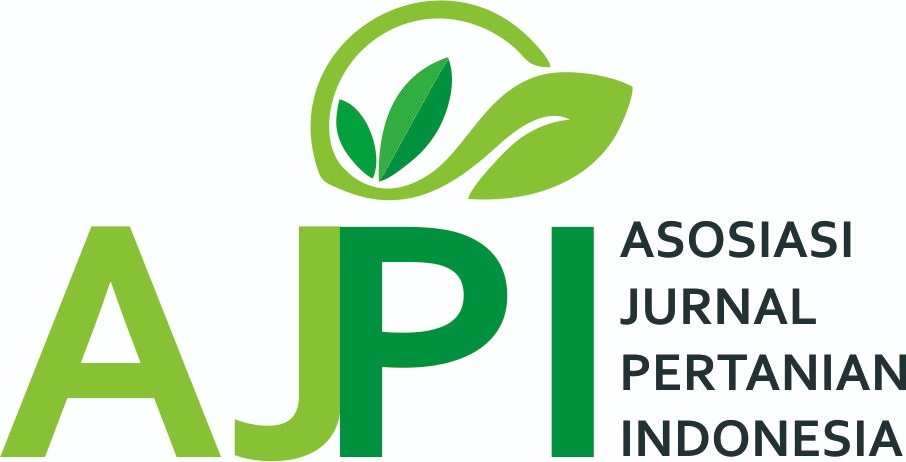Productivity of several upland rice under aluminum stress in acid dry land east lampung regency
Abstract
Aluminum stress is a limiting factor for crop production on acid dry land with a low pH. The objectives of this study were to obtain aluminum-tolerant upland rice varieties in acid dry land. The study was carried out using a completely randomized block design (RCBD) consisting of 8 varieties, namely IR64, Inpago 7, Dodokan, Situ Bagendit, Dod-Pup1, Situ Bg-Pup1, Batur-Pup1, Batur and 4 strains, namely 19 (PB5)-2, 20 (PB8)-1, 21 (PB15)-1, and 22 (PB16)-1. The results also showed that the Situ Bagendit variety with the Pup-1 locus gave the highest yield per plot compared to other varieties and lines, namely 287.5 g. These results also correlate with the ability of the variety to withstand aluminum stress, with a tolerance value of 3.00 (quite tolerant).
Downloads
References
BBPADI. (2018). Padi Gogo Potensi Hasil Tinggi. http://www.bbpadi.litbang.pertanian.go.id
Bojórquez-Quintal, E., Escalante-Magaña, C., Echevarría-Machado, I., & Martínez-Estévez, M. (2017). Aluminum, a Friend or Foe of Higher Plants in Acid Soils. Frontiers in Plant Science, 8. https://www.frontiersin.org/articles/10.3389/fpls.2017.01767
Igbokwe, I. O., Igwenagu, E., & Igbokwe, N. A. (2019). Aluminium toxicosis: a review of toxic actions and effects. Interdisciplinary Toxicology, 12(2), 45.
International Rice Research Institute. (1996). Standard Evaluation System for Rice. https://www.irri.org
Kementan. (2019). Basis Data Konsumsi Pangan. https://pertanian.go.id/home/?show=page&act=view&id=61
Kujane, K., Sedibe, M. M., & Mofokeng, M. A. (2021). Assessment of genetic diversity among soybean (Glycine max (l.) Merr.) genotypes making use of agro-morphological based on nutritional quality traits. APPLIED ECOLOGY AND ENVIRONMENTAL RESEARCH, 19(5), 3703–3716.
Kurniawati, N., & Priyadi, F. (2021). Pengaruh Aplikasi Abu Terbang dan Pupuk Kotoran Sapi terhadap Populasi Mikroorganisme di Tanah Ultisol. Agriprima: Journal of Applied Agricultural Sciences, 5(1), 41–49. https://doi.org/10.25047/agriprima.v5i1.406
Larasati, E. D., Rukmi, M. G. I., Kusdiyantini, E., & Ginting, R. C. B. (2018). Isolasi dan identifikasi bakteri pelarut fosfat dari tanah gambut. Bioma: Berkala Ilmiah Biologi, 20(1), 1–8.
Lechner, A. M., Baumgartl, T., Matthew, P., & Glenn, V. (2016). The impact of underground longwall mining on prime agricultural land: a review and research agenda. Land Degradation & Development, 27(6), 1650–1663.
Li, P., Chen, Y.-H., Lu, J., Zhang, C.-Q., Liu, Q.-Q., & Li, Q.-F. (2022). Genes and their molecular functions determining seed structure, components, and quality of rice. Rice, 15(1), 18.
Lusmaniar, L., Oksilia, O., & Nera, K. (2022). Application of rice husk biochar and a combination of urea, SP 36 and KCl on yield components and yields of glutinous corn (Zea mays Ceratina) on ultisols. Jurnal Agrotek Ummat, 9(1), 26–34.
Magfiroh, N., Lapanjang, I. M., & Made, U. (2017). Pengaruh jarak tanam terhadap pertumbuhan dan hasil tanaman padi (Oryza sativa l.) pada pola jarak tanam yang berbeda dalam sistem tabela. AGROTEKBIS: E-JURNAL ILMU PERTANIAN, 5(2), 212–221.
Ofoe, R., Thomas, R. H., Asiedu, S. K., Wang-Pruski, G., Fofana, B., & Abbey, Lord. (2023). Aluminum in plant: Benefits, toxicity and tolerance mechanisms. Frontiers in Plant Science, 13. https://www.frontiersin.org/articles/10.3389/fpls.2022.1085998
Priyadi, Taisa, R., Dulbari, Rahmadi, R., & Rochman, F. (2023). Pertumbuhan dan Hasil Beberapa Varietas Padi Gogo Toleran Alumunium di Lahan Kering Masam Lampung Timur. JURNAL AGRI-TEK: Jurnal Penelitian Ilmu-Ilmu Eksakta, 24(1), 19–25. https://doi.org/10.33319/agtek.v25i1.134
Roy, S. C., & Shil, P. (2020). Assessment of Genetic Heritability in Rice Breeding Lines Based on Morphological Traits and Caryopsis Ultrastructure. Scientific Reports, 10(1), 7830. https://doi.org/10.1038/s41598-020-63976-8
Sujitno, E., Fahmi, T., & Teddy, S. (2011). Kajian adaptasi beberapa varietas unggul padi gogo pada lahan kering dataran rendah di Kabupaten Garut.
Toriyama, K. (2021). Molecular basis of cytoplasmic male sterility and fertility restoration in rice. Plant Biotechnology, 38(3), 285–295.
Tyagi, W., Yumnam, J. S., Sen, D., & Rai, M. (2020). Root transcriptome reveals efficient cell signaling and energy conservation key to aluminum toxicity tolerance in acidic soil adapted rice genotype. Scientific Reports, 10(1), 4580.
Utami, D., Halim, A., & Ichsan, C. N. (2019). Pengaruh intensitas cahaya terhadap pertumbuhan dan hasil beberapa varietas padi. Jurnal Ilmiah Mahasiswa Pertanian, 4(1), 210–218.
Wang, B., Zhang, H., Zhu, X., & Shen, R. (2017). Differences in aluminium tolerance between rice varieties. Acta Pedologica Sinica, 54(4), 958–966.
Zhu, H., Bing, H., & Wu, Y. (2022). Citric acid promotes the mobilization of phosphorus under the lower concentration of low molecular weight organic acids in acidic forest soil. Adsorption Science & Technology, 2022, 1–9.
Copyright (c) 2023 Priyadi Priyadi, Rianida Taisa, Dulbari Dulbari, Rizky Rahmadi, Fajar Rochman

This work is licensed under a Creative Commons Attribution-ShareAlike 4.0 International License.
Author retains the copyright and grants the journal the right of first publication of the work simultaneously licensed under the Creative Commons Attribution-ShareAlike 4.0 License that allows others to share the work with an acknowledgement of the work's authorship and initial publication in this journal













